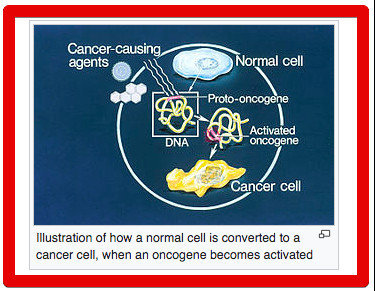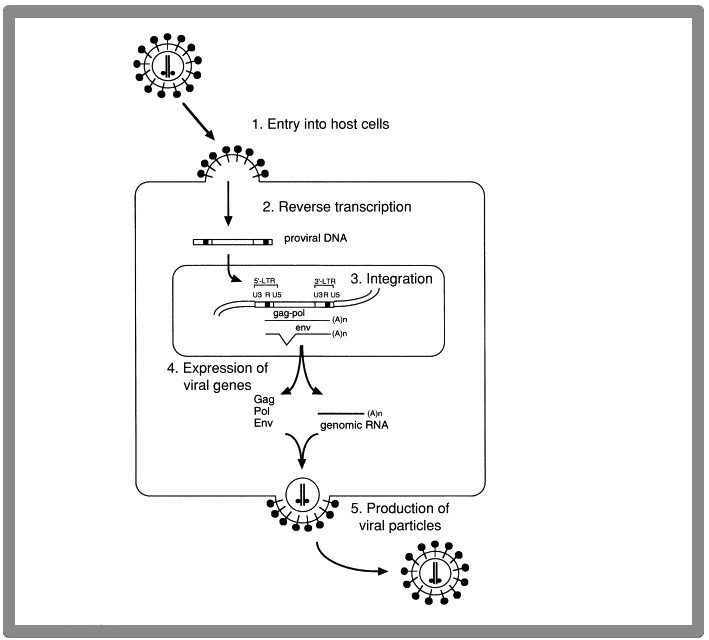Human endogenous retroviruses, abbreviated HERVs, have persisted for millions of years to infect the human genome. Approximately 8% of the genome is comprised of HERVs, the majority of which are nonfunctional due to deactivated mutations or epigenetic control factors. There is a correlation between retroviruses and cancerous tumors, including breast and ovarian cancer, renal cancer, and melanoma.

Table of Contents
What Are Retroviruses?
Retroviruses are a subcategory of viruses characterized by their unique ability to assimilate their genome into the DNA of host cells. These double-stranded viruses, whose genetic blueprint is carried in the form of RNA, use reverse transcriptase enzymes to transcribe their RNA to DNA.
Normal cellular transcriptase transcribes DNA into RNA, as is the case with the more familiar DNA viruses. This transcription of DNA to RNA results in the manufacture of viral proteins. Reverse transcription allows retroviral genetic material to be permanently incorporated into the genomic DNA of an infected host cell via a viral integrase enzyme. Retroviruses are then able to replicate by utilizing the cellular machinery of the host.
Retroviruses and Epigenetics
HERVs can potentially cause chronic diseases that are autoimmune in nature, along with certain types of cancer, and do so through a variety of mechanisms. The expression of HERV proteins have been identified in malignant tissues. Interestingly, retrovirus transcription is dependent on mechanisms related to epigenetics, which is the study of how genes are modified and expressed due to structural changes in DNA, excluding alterations in the genetic code itself. Genes can be turned on or off when DNA is externally modified.
Some retroviruses cause infectious disease, with some causing cancer in both humans and animals. HIV-1 is an example of a retrovirus that causes the devastating infectious disease we know as AIDS. Retroviruses are classified as either class 1 or II based on whether their sequencing is homologous to mammalian type C or type B and D retroviruses. Subdivisions of retroviruses include Beta retroviruses: HERV-K, and Gamma retroviruses: HERV-H and HERV-W.
Listen to the brilliant virologist Judy Mikovits talk about the connection between retroviruses and chronic disease:
Affiliate Links ✔️
Retroviruses and Oncogenesis
Oncogenes are genes that can potentially cause cancer. They are commonly mutated or highly expressed in tumor cells. Oncogenes that have become activated can curtail apoptosis, a protective process of programmed cell death. Interruption of this process allows diseased cells, which should have been eliminated, to survive and proliferate.
Oncogenes originate as proto-oncogenes, which are normal genes involved in cellular growth and proliferation. However, if these genes mutate, they can become upregulated and permanently activated, predisposing cells to malignancy. Multiple oncogenes, operating in conjunction with mutated genes and tumor suppressor genes, act in concert to cause cancer. Dozens of these genes have been identified in human cancers over the last 50 years, with many cancer drugs targeting the proteins that oncogenes encode.
Many cancer-promoting oncogenes were initially recognized in retroviruses. Oncogenesis, also called carcinogenesis, is a process in which normal cells turn malignant, resulting in tumor formation. Retroviruses cause oncogenesis through several mechanisms, one of which is the encoding of oncogenic proteins that interact with transcription factors to activate immunosuppressive pathways. This immunosuppressive response can then induce the formation and spread of cancer.
The Virulence Factor
Scientists have identified an inhibitory host-immune response called “the virulence factor,” a sequence of amino acids within the envelope protein of the virus, which enables it to spread and exert its pathogenic effect. Retroviruses may persist and thrive in their hosts due to their ability to evade the immune system. This ability is driven by envelope proteins, which allow viral proteins to be fused within the cell membrane of the target, with subsequent penetration into the cell.
A secondary role of envelope proteins within a virus, that further enable propagation, is the immunosuppressive effect they have on the adaptive and innate immune responses. Researchers have introduced targeted mutations into envelope proteins in the hope of suppressing their ability to impede immune function, resulting in antibody production and antiviral immunity within the cell. This pivotal research will likely factor into the development of future vaccines.
People with compromised immune vigilance systems against viruses have an increased risk of developing cancer, which may be due to uncontrolled HERV expression. HERV research has identified 12 host oncogenes.
 Source: Wikipedia.org
Source: Wikipedia.org
Oncogenic Retroviruses
Oncogenic retroviruses are a category of viruses that cause certain types of cancer and other abnormalities. Retroviruses are unique in that they are composed of single-strands of RNA.
They replicate by forming double strands of DNA, which are then integrated into the genome of the host cell. The reverse transcriptase enzyme referred to above is fundamental in retrovirus replication.
Once the virus is assimilated into the host cell, proteins that transform normal cells into malignant cells are produced. Promoter and enhancer sequences contained within the retroviral genome are thought to trigger cell division, while activating adjacent host genes.
The expression of viral proteins may contribute to a process called transactivation, which is the activation of genes within the host itself. Furthermore, oncogenes contained within the viral genome may transform cells directly once they’re incorporated into the genome of the host cell.
Retrovirus Infection Life Cycle
The following sequential steps outline how a retrovirus infects a host by utilizing the host cell’s machinery for their own propagation:
1. Entry into host cells via interaction with the host cell’s surface molecules. Following interaction, the cell membranes of the host and the virus fuse together, allowing the virion core delivery into the host cell’s cytoplasm.
2. Reverse transcription: Once the virion core is within the cytoplasm, the reverse transcriptase enzyme initiates reverse transcription, followed by the production of minus-strand DNA, and the synthesis of double-strand proviral DNA.
3. Integration: The nuclear membrane is broken down to allow the double-strand proviral DNA to enter the nucleus of the host cell, afterwhich a single copy of the proviral DNA is integrated into the chromosomal DNA of the host via a process controlled by integrase. Retrovrial integrases are specialized recombinases (enzymes that control gene expression) which catalyze the insertion of viral DNA into the DNA of the host cell, enabling propagation.
4. Expression of viral genes: A promoter directs transcription. RNA is cleaved and packaged into complete virion particles, which consist of an external protein shell, and an inner nucleic acid core.
5. Production of viral particles: Full-length RNA is packaged into virion particles, reverse transcriptase and host tRNA are incorporated into virus particles, resulting in these particles budding from the surface of the cell.
Source: Science Direct
Types Of Retroviruses
Human T-cell lymphotropic virus type 1 (HTLV-1) is implicated in a type of human cancer called adult T-cell leukemia (ATL).
This same retrovirus can also cause HTLV-1-associated myelopathy/tropical spastic paraparesis (HAM/TSP), a neurodegenerative condition. XMRV is another oncogenic retroviruses associated with leukemia and prostate cancer.
HTLV-2, is a similar virus that causes mild neurological disorders.
Although, millions of people worldwide are infected with HTLV retroviruses, relatively few go on to develop ATL or HAM/TSP. HTLV-1 was discovered and isolated in 1979 by Robert C. Gallo, an American virologist.
Before this time, it was known that retroviruses caused different types of leukemia and lymphoma, along with solid tumors in animals, but it wasn’t until 1979 that the first human oncogenic retrovirus was discovered. HIV, the retrovirus that causes AIDS was isolated soon thereafter in 1983.
How Infection Occurs
Retroviral infections can be acquired through physical contact, exposure to infected blood, via inhalation, or passed from mother to child during pregnancy. Drivers of chronic illness, such as chronic inflammation, oxidative stress, and microbial infections are known triggers that can potentially activate retroviruses already present in one’s own DNA.
Oral cavitations and heavy metals are additional triggers. HERVs can also be acquired through vaccines, which contain animal-based retroviruses. It’s likely that retroviruses are activated by more than one trigger. For instance, the expression of the HERV-K envelope gene can be induced by the Epstein Barr virus.
The transactivation of MSRV, the Multiple Sclerosis retrovirus, can be induced by Epstein Barr. Herpes simplex type-2 can activate viruses in the HERV-W family, and are implicated in the activation of retroviruses associated with autoimmune diseases (Sjogren’s disease, SLE, MS, and rheumatoid arthritis), autism, schizophrenia, and cancer.
Retroviral Mechanics
Retroviruses cause neurological diseases through a variety of mechanisms:
- Directly, by infecting immune cells that are trafficked to the brain
- Indirectly, by increasing chemokines and pro-inflammatory cytokines
- Indirectly, through an effect called the “bystander effect,” which is a chronic retroviral replication of immune system cells
Electromagnetic radiation, emitted from cell phones and WiFi, has a significantly negative impact on many of the protective proteins within the body. Food-based toxins, such as glyphosate, along with air-borne pollutants, including aluminum are also damaging to critical proteins.

 Retroviruses and Chronic Illness
Retroviruses and Chronic Illness
The role that retroviruses play in chronic illness is disputed. However, Dr. Dietrich Klinghardt, MD, PhD, has seen significant improvements in his patients with chronic illness when strategies that address retroviruses are included in the treatment protocol.
The list of diseases that are potentially caused by activated retroviruses is extensive. These include central-nervous system illnesses, such as autism, Parkinson’s, ALS, MS, ME/CFS, and Gulf War syndrome.
Retroviruses may be the cause of, or a contributing factor, in the development of autoimmune diseases, such as Crohn’s disease, lupus, polymyositis, Bechet’s disease, Hashimoto’s thyroiditis, and primary biliary cirrhosis, and conditions like mast cell activation and chronic fatigue syndrome.
Retroviruses are associated with certain types of cancer, including non-Hodgkin’s lymphoma, hairy cell leukemia, chronic lymphocytic leukemia, mantle cell lymphoma, and cancers of the prostate, breast, ovaries, lungs, kidneys, bladder, and colon. Other diseases, including Lyme disease, ADHD, asthma, most childhood illnesses, and mold illness have responded favorably to treatments that address retroviruses, as have conditions like insomnia and brain fog.
Natural Anti-Viral Compounds
Dr. Klinghardt has noted that treatment outcomes are more effective when retroviruses are addressed in the early stages of chronic illness. Patients become less symptomatic, in terms of parasitic infections, heavy metal toxicity, and silent inflammation, while at the same time responding better to interventions.
Since plants have been exposed to retroviruses for millions of year, they’ve developed powerful adaptogenic compounds that can be used to eradicate HERVs. Below are four plant-based products that have anti-retroviral properties:
- Cistus incanus: A Mediterranean plant that is a potent source of polyphenols and antioxidants that support immune function, dissolve biofilms, support the microbiome, and prevent infections caused by human immunodeficiency viruses (AIDs). It also impedes the adherence of viral proteins to cells.
- Broccoli sprout extract: Sulforaphane, a compound in broccoli, silences the activity of retroviruses, quells inflammation in the brain, and has shown success in cases of autism. You can sprout broccoli yourself at home. The sprouts need to be chewed thoroughly to be converted to sulphoraphane. The dosage is one to two tablespoons per day.
- St. John’s Wort: A leafy herb with impressive ant-viral activity that prevents viruses from fusing to host cell membranes.
- Scutalaria root (Scullcap root): Scutalaria root is cytotoxic to human malignancies, is hepatic protective, and has been shown to have both antiviral and antibacterial properties. It inhibits the HIV-1 integrase enzyme and is one of the leading compounds used to prevent HIV infections.
- Chlorella: Promotes the release of glyphosate and heavy metals like mercury and aluminum.
- Reishi mushrooms: The Ganoderma lucidum, or Reishi mushroom, contains polysaccharides, antioxidants, and triterpenoids that boost immunity, reduce inflammation, inhibit the progression of the retrovirus HIV-1, and prevent tumor growth by inducing apoptosis and inhibiting angiogenesis. Read my post below to learn how to make Reishi tea in a crockpot using whole mushrooms.
[Read More: The Best Medicinal Mushrooms For Cancer]
Environmental Factors
Plant compounds are used in conjunction with EMR protection, anti-microbial protocols, and heavy metal and mold detoxification. It’s paramount that WiFi and cell phones be turned off at night as electromagnetic radiation inhibits detoxification. Retroviruses can be activated by faulty detoxification so this is not an insignificant matter.
Although, there are no specific tests to date for individual retroviruses, elevated levels (above 0.6-0.7) of Nagalase are indicative of viral overload. You can access direct-to-consumer lab testing here.
Key Points
Retroviruses play a role in the development of chronic disease, including cancer. Contributers to illness, namely inflammation, infections, and oxidative stress are known retroviral activators. Likewise, these same contributers are caused by retroviruses.
Environmental factors, such as GMOs, mold, and EMFs, are also key factors in retroviral activation. Significant improvements in treatment outcomes are seen when retroviral activity is addressed. Retroviruses affect a small percentage of the population, yet could be the missing link in some people with chronic disease.
Have you heard of retroviruses? Let me know in the comments:)
References:
(1) NCBI: Retroviruses and Cancer
(2) NCBI: Human endogenous retroviruses and cancer
(3) Live Science: Epigenetics: Definition & Examples
(4) nature.com: Oncogenesis
(5) NCBI: Human Retroviruses
(6) Cancer.org: Oncogenes and tumor suppressor genes
(7) Science Daily: ‘Secret weapon’ of retroviruses that cause cancer
(8) Oxford Academic: Clinical Infectious Diseases
(9) cancer network: Retrovirus-Associated Malignancies
(10) Science Direct: Virus Vectors for use in the Central Nervous System
(11) NCBI: RETROVIRAL INTEGRASE: THEN AND NOW
(12) IHCAN Special Report: The role of retroviruses in chronic illness – a clinician’s perspective
(13) NCBI: Virulence: Detection of an infectious retrovirus, XMRV, in blood cells of patients with chronic fatigue syndrome
(14) NCBI: Potent in vitro antiviral activity of Cistus incanus extract against HIV and Filoviruses targets viral envelope proteins
(15) National Library of Medicine: Cistus Incanus (CYSTUS052) for Treating Patients With Infection of the Upper Respiratory Tract. A Prospective, Randomised, Placebo-Controlled Clinical Study
(16) NCBI: Effect of Broccoli Sprouts and Live Attenuated Influenza Virus on Peripheral Blood Natural Killer Cells: A Randomized, Double-Blind Study
(17) Klinghardt Institute: Dr. Klinghardt Retroviral Protocol PDF
(18) NCBI: Medical Attributes of St. John’s Wort (Hypericum perforatum)
(19) NCBI: Antitumour, Antimicrobial, Antioxidant and Antiacetylcholinesterase Effect of Ganoderma Lucidum Terpenoids and Polysaccharides: A Review
(20) NCBI: Scutellaria baicalensis, the golden herb from the garden of Chinese medicinal plants
Disclaimer: This article is strictly for informational purposes only and is not intended to be medical advice.



Hi,
I have not heard of retroviruses, but after reading your post some things began to make sense to me. A friend of mine who has always easily gotten ill throughout her life got breast cancer a few years ago. It was an aggressive cancer, but fortunately she survived it.
Are retroviruses part of our DNA? Are they already in our bodies and only get released due to the causes you described in your article? I am glad that you mentioned foods that have natural anti-viral compounds. I often eat broccoli, but when you say broccoli sprouts, do you mean sprouted broccoli seeds? I actually planted some broccoli a few weeks ago, but it is still tiny.
Chlorella is also a super food, I think I may get that one. I have heard of reishi mushrooms, but not the other supplements you mentioned.
Hi Christine,
You’re not alone, most people aren’t familiar with retroviruses. Even if they have heard of them, they don’t understand the role that they play in chronic disease or how they differ from traditional viruses. I’m sorry to hear about your friend with cancer, but glad to hear she’s doing well currently.
Retroviruses can be assimilated into our DNA via RNA reverse transcription. They can then be triggered by inflammation, oxidative stress, microbial infections, heavy metals, glyphosate, and electromagnetic radiation, to name a few triggers. Even emotional stress is implicated in their activation.
Yes, I referred to broccoli sprouts in my article. It’s easy to make your own and you only need a tablespoon a day to target retroviruses. Since you’ve planted some, you should definitely sprout them. They taste good and have a delightful crunch to them. Eat them plain, or add them to salads, soups, smoothies, or sandwiches.
Cistus tea is one of my favorite supplements if you have a chronic condition. It’s both anti-inflammatory and antimicrobial and is amazing for breaking down biofilms, slimy encasements that pathogens encase themselves in to evade the immune system. It’s also effective at releasing heavy metals. It’s inexpensive and tastes good. Plus, it will make you repellent to ticks (carriers of Lyme disease) and other insects.
Chlorella is good for mobilizing heavy metals, which can trigger retroviral activation. Reishi mushrooms are beneficial for immune function. It’s super easy to make reishi tea in a crockpot at home. I’m certainly all for inexpensive, yet effective remedies. Thanks so much for reading. I appreciate your comment:)
This is a classic article that helped me understand the relationship between retroviruses and cancer. The fact that HERVs have been in existence for so long tells a lot about their ability to mutate and survive.
From what I learned from this post, when retroviruses are addressed as causative of chronic disease, treatment protocols will be more effective, and will go a long way in identifying both the symptoms and the triggers.
I think the first step everyone can take is to ensure that their mobile devices are switched off to avoid electromagnetic radiation.
Hi Israel,
Thank you. Yes, retroviruses have existed for a very long time. Most people haven’t heard of them, although everyone knows what DNA viruses are, especially today as we’re witnessing the effects of Covid-19. Chronic disease is rampant in today’s society, when retroviruses are addressed as potential causes of cancer, autoimmune diseases, and other chronic conditions, treatment protocols are more likely to resolve symptoms.
Absolutely, turning off WiFi and cell phones at night is critical for not activating retroviruses because faulty detoxification can trigger their expression. Staying away from GMOs and heavy metals as much as possible is also key.
Thanks so much for reading my post and for taking the time to leave a comment:)
Hello dear, wow what wonderful content you have here. I really want to thank you for the hard work you put into bringing this site together, and for providing such informative and concise information. This is the first time I have heard about retroviruses, and I learned a lot. I already saved this page so as to come back for future reference. Thanks for the info!
Thank you for reading my post. Retroviral activity and how retroviruses are activated is pertinent information for anyone with cancer or chronic disease because it can be a key component of how the condition is addressed. I appreciate your comment:)
Hello there, This is an amazing article that you have written. You have shared a well-detailed description about what retroviruses are. I really learned a lot from this article, including how infections can be activated and the different triggers that can activate them. I am so glad that I stumbled on this information here on your website.
Thanks for sharing this with me.
Hello,
Thank you so much. I thought it important to share information on what retroviruses are, along with potential triggers that can activate them. It’s all part of the broader picture when it comes to chronic disease. Thanks for taking the time to leave a comment:)
Thank you. You have done a nice job gathering important informative on retroviruses and their correlation to cancer. Sincerely speaking, this is actually my first time learning about these types of viruses. It sounds like they factor in to how chronic disease is treated. Interesting subject – thanks again for sharing info on a subject that not too many people know about but that is relevant to their health.
Thank you reading my post on retroviruses and their correlation to cancer. It’s not surprising that you haven’t heard of retroviruses – most people aren’t aware of them. I do believe it’s an important subject since protocols that include addressing these types of viruses does improve outcomes. Thanks for your comment:)
Hello there, thanks for this insightful review. Very informative. Well, it seems that retroviruses are best known for causing contagious diseases such as AIDS, or more sporadically, cancer. Most scientists have become used to the view that retroviruses are generally harmless, but may be a critical components of chronic disease. Many diseases that the world is battling today may have an underlying retroviral component.
Thank you. Yes, retroviruses are implicated in some diseases and can be activated by environmental triggers. It’s an interesting subject that I hope continues to receive increasingly more and more attention. Thanks for your comment:)